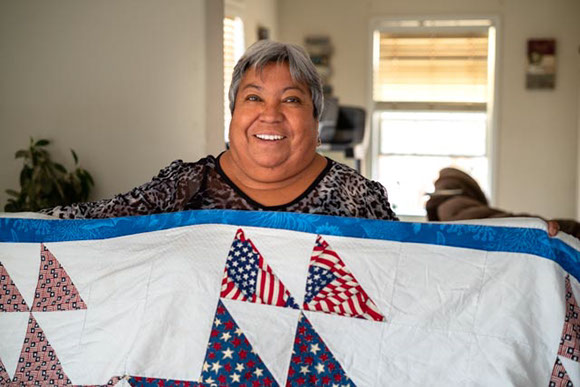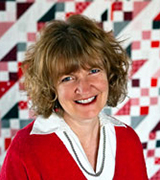Maria Ignacia Sanchez, Boquillas Quilter
Maria Ignacia Sanchez was born and lived most of her life in the tiny Mexican village of Boquillas del Carmen, just across the Rio Grande from Texas’s Big Bend National Park. Like the other residents of Boquillas, she and her family’s livelihood depended on Park visitors coming to their village to eat, drink and purchase the handmade crafts that Maria and others made.

When the border crossing from the Park to Boquillas was closed for 12 years after 9/11, the village economy collapsed. With help from friends in Texas, Maria and other women of the village helped keep Boquillas alive by selling the quilts they made to buyers in the United States.
Unlike many of the other women in Boquillas, who learned to quilt from Texas quilters brought to the village by Cynta de Narvaez after the border crossing closed in 2001, Maria already knew how to quilt. Maria learned how to sew and make quilts from her grandmother and mother.
Winter can get cold in the high mountain desert, and Maria’s grandmother and mother made quilts to keep their family warm. “In the old days, they would make batting out of wool from sheep that they raised,” says Maria (as translated from Spanish by her daughter, Maria Ureste). “Sometimes we would use old blankets or worn-out quilts as batts. I used to make a lot of quilts out of polyester but I didn’t put any batt inside of those quilts because polyester is a hot fabric. When Cynta began providing donated materials to us, I used cotton. That’s what I use now.”
Because Boquillas did not have electricity until 2015, when the Mexican government installed solar panels in the village (money earned from selling quilts had also funded some solar panels), Maria has always used her grandmother’s treadle sewing machine to piece her quilt tops.
She quilts them by hand by laying the backing, batting, and top on a bed and quilting it there, taking care to make sure that the layers don’t shift, since there is no frame to hold them taut. She binds a quilt by bringing backing fabric over to the top and sewing it down. She always quilts alone. “I talk with other quilters in Boquillas about fabrics and designs, but we don’t quilt together,” Maria says.
During the years that the border was closed and Maria was making quilts to help support her family, she would make as many as ten a month. Cynta de Narvaez recalls that time: “When I was helping the town, Maria was helping me. I stayed with her and she was an invaluable friend. She is a strong woman. She lives for her family and for quilting.”
Since the border reopened in 2013, things have gotten much better for everyone in Boquillas. Maria hasn’t been quilting as much lately, spending more time embroidering colorful tortilla covers that her daughters finish with a crocheted edge. These are quicker to do and more portable, so she can work on them when she visits her daughter in Marfa, Texas.
That doesn’t mean she has stopped quilting though. She has made quilts for all her grandchildren and is working on one for the newest granddaughter. Her face breaks into a megawatt smile when she talks about quilting: “I don’t have a lot of words, but I really love it!”



